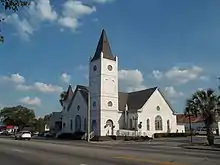African Americans in Florida
African Americans in Florida are residents of the state of Florida who are of African ancestry. As of the 2010 U.S. Census, African Americans were 16.6% of the state's population.[1] The African-American presence in the peninsula extends as far back as the early 18th century, when African-American slaves escaped from slavery in Georgia into the swamps of the peninsula. Black slaves were brought to Florida by Spanish conquistadors.
 African American church in Palatka, Florida. | |
| Regions with significant populations | |
|---|---|
| Lauderdale Lakes, Lauderhill, Riviera Beach, Miami Gardens, Pahokee, Quincy, North Miami, Belle Glade, Opa-locka, North Lauderdale, Gladeview | |
| Languages | |
| Southern American English, African-American Vernacular English, Haitian Creole | |
| Religion | |
| Christianity, Islam, atheism, Haitian Voodoo | |
| Related ethnic groups | |
| Afro-Cubans, Afro-Caribbeans |
.jpg.webp)
| Part of a series on |
| African Americans |
|---|
|
History
The history of African Americans in Florida can be divided into several eras, the dates varying by location: 1) Slavery until 1865. A few slaves had been freed, but were never free from the threat of being again enslaved. 2) Reconstruction after the American Civil War. 3) Remainder of 19th century. 4) Terrorist activity against African Americans. 5) Civil Rights Era. 5) Late 20th-21st century.
The history of Black people in Florida, however, dates back to the pre-American period, beginning with the arrival of Congolese-Spanish conquistador Juan Garrido in 1513, the enslaved Afro-Spanish explorer Estevanico in 1528, and the landing of free and African enslaved persons at Mission Nombre de Dios in the future St. Augustine, Florida in 1565.
The first Black city in the state came in the latter region, when a military outpost of free Black settlers was established at Fort Mose when the Black population became numerous in St Augustine. The uptick was largely due to fugitive slaves from British colonies in North America to Spanish Florida where they were promised freedom in exchange for military service.
Florida was later acquired by the United States, bringing the Spanish era to an end and the departure of the Afro-Spanish population to Cuba. African-American slaves soon became the main Black population in the state.
After the Civil War, there was a brief Reconstruction era from 1867 to 1877. This included enforcement of rights for African Americans. This era vanished suddenly, the result of the Compromise of 1877.[2]
Post-reconstruction policies allowed civil rights for blacks to lapse. Black voters and black politicians vanished under threats from reactionary whites.[3]
Per capita lynching was highest in Florida than any other state from 1900-1930. Offenders were often known, but no legal proceedings ensued. A tipping point was reached in 1951, with the Murder of Harry and Harriette Moore. FBI help was sought. The KKK was suspected, but there was insufficient evidence for trial.[4] A violent era was followed by continued segregation.
Governor LeRoy Collins took the position that segregation was morally unfair and wrong.[5] This was succeeded by Federal Civil Rights Act in 1964. Schools were integrated, but not without difficulty.
Population
As of 2010, those of African ancestry accounted for 16.0% of Florida's population, which includes African Americans. Out of the 16.0%, 4.0% (741,879) were West Indian or Afro-Caribbean American. During the early 1900s, black people made up nearly half of the state's population. In response to segregation, disfranchisement and agricultural depression, many African Americans migrated from Florida to northern cities in the Great Migration, in waves from 1910 to 1940, and again starting in the later 1940s. They moved for jobs, better education for their children and the chance to vote and participate in society. By 1960, the proportion of African Americans in the state had declined to 18%. Conversely, large numbers of northern whites moved to the state. Today, large concentrations of black residents can be found in northern and central Florida. Aside from blacks descended from African slaves brought to the southern U.S., there are also large numbers of blacks of West Indian, recent African, and Afro-Latino immigrant origins, especially in the Miami/South Florida area.
Notable people
- John Gilmore Riley (1857–1954)
- James Weldon Johnson (1871–1938)
- Dr. Mary McLeod Bethune (1875–1955)
- Zora Neale Hurston (1891–1960)
- Augusta Savage (1892–1962)
- Thelma “Butterfly” McQueen (1911–1995)
- Jackie Robinson (1919–1972)
- Lillette Jenkins-Wisner (born in 1924)
- Sidney Poitier
- George “Buster” Cooper (1929–2016)
- Clarence Fort (born in 1938)
- Alfred “Freddie” Hair (1941–1970)
- Peggy Quince (born in 1941)
- Angela Bassett (born in 1958)
- Emmitt Smith (born in 1969)
- Maya Rudolph (born in 1972)
- Eric Darius (born in 1982)
- Flo Rida (born 1979)
- Rick Ross (born 1976)
- Plies (born 1976)
See also
External links
- Carol E. Mundy Collection - RICHES Mosaic Interface
- Florida's African-American History Trail
- The 1526 Project: Horrors in Florida's Black History You Didn't Learn in School
- Slavery took hold in Florida under the Spanish in the ‘forgotten century’ of 1492-1619. | Column
- http://floridahistory.org/ybor6.htm
References
- "Florida QuickFacts from the US Census Bureau". Quickfacts.census.gov. 2011. Archived from the original on May 8, 2013. Retrieved January 20, 2014.
- C. Vann Woodward, Reunion and reaction: the compromise of 1877 and the end of reconstruction (1956), pp. 3–15
- The long, racist history of Florida’s now-repealed ban on felons voting
- Crist, Charlie; Attorney General (August 16, 2006). "The Christmas 1951 Murders of Harry T. and Harriette V. Moore; Results of the Attorney General's Investigation: Executive Summary" (PDF). Retrieved February 27, 2018.
- Dyckman, Martin. "LeRoy Collins, Trent Lott: a study in contrasts". Retrieved 10 September 2013.
_(cropped2).jpg.webp)